
A basic understanding of Poker is crucial to playing well. The game requires the player to understand basic rules, such as how to check the pot and call a raise. Bluffing, betting intervals, and other important poker strategies are also discussed. Here’s a brief rundown of these topics. Once you have an understanding of the basics of the game, you’ll be ready to join a poker tournament. Getting started with poker is a simple process – just follow these tips to get started playing online!
Basic rules of poker
The game of poker is played by a group of people sitting around a large round table. There are usually between eight and nine people participating in a game. The object of the game is to collect other players’ chips while maintaining a cool demeanor. The odds of winning a hand depend on many factors including the behavior of your opponents and how you read their behavior. Despite this, the basic rules of poker are the same for every game of poker.
Highest possible hand in poker
In most card games, the ace is the highest possible hand. In most cases, the ace beats any other hand, except two pairs. Sometimes a pair of aces is better than an ace, but that hand is still weak against an ace. While there are exceptions, the ace is the highest possible hand in poker. If you have this hand, you should always come in first. Pairs do not beat an ace, but they are a good hand to have.
Bluffing strategy in poker
When deciding whether to bluff, it is crucial to keep your opponents guessing. Bluffing keeps your opponents off-guard and makes it easier to get paid for big hands. However, if your opponents know you can bluff, they are more likely to call your bets. This can help you win more pots and become more profitable in the long run. However, you must know that bluffing is not suitable for all situations.
Betting intervals in poker
Poker betting intervals are periods in the game during which a player can make a bet or raise a previous bet. These intervals may last anywhere from two seconds to seven minutes. During these intervals, you can determine who will win the hand and how much money each player should bet. The first bettor, usually the player to the left of the dealer, must make a bet during the first betting interval. In subsequent rounds, he or she can check his or her bets.
Limits on bets and raises in poker
The limits on bets and raises in poker govern how much each player can raise or bet in a hand. There are four common limits in poker, each of which has its own strategy for betting and raising. A full raise entitles a player to make a full bet, but a smaller all-in raise does not. Increasing the limit in a game is not always desirable, but it is usually a good strategy to follow if you want to win more money.
Community card games
Two different types of poker games include stud and community card games. Seven Card Stud games use community cards and a fifty-two-card deck. The dealer must make sure there are enough cards in the deck to accommodate all players, as well as ensure that there are at least seven cards in the deck. The bottom card of the deck is not in play. Each hand has its own rules, but the highest-ranking hand wins the pot.
Five-card draw
One of the most basic forms of poker is Five-Card Draw, a variant that allows players to discard one card. This variation differs from other forms of poker in that players do not have to break ties using suits. Instead, players should use their own skills and judgment when determining whether to make a draw or stay in the game. The following five-card-draw strategy may help you improve your odds. However, it will depend on a variety of factors, including the betting structure, your opponents’ positions and the situation at hand.